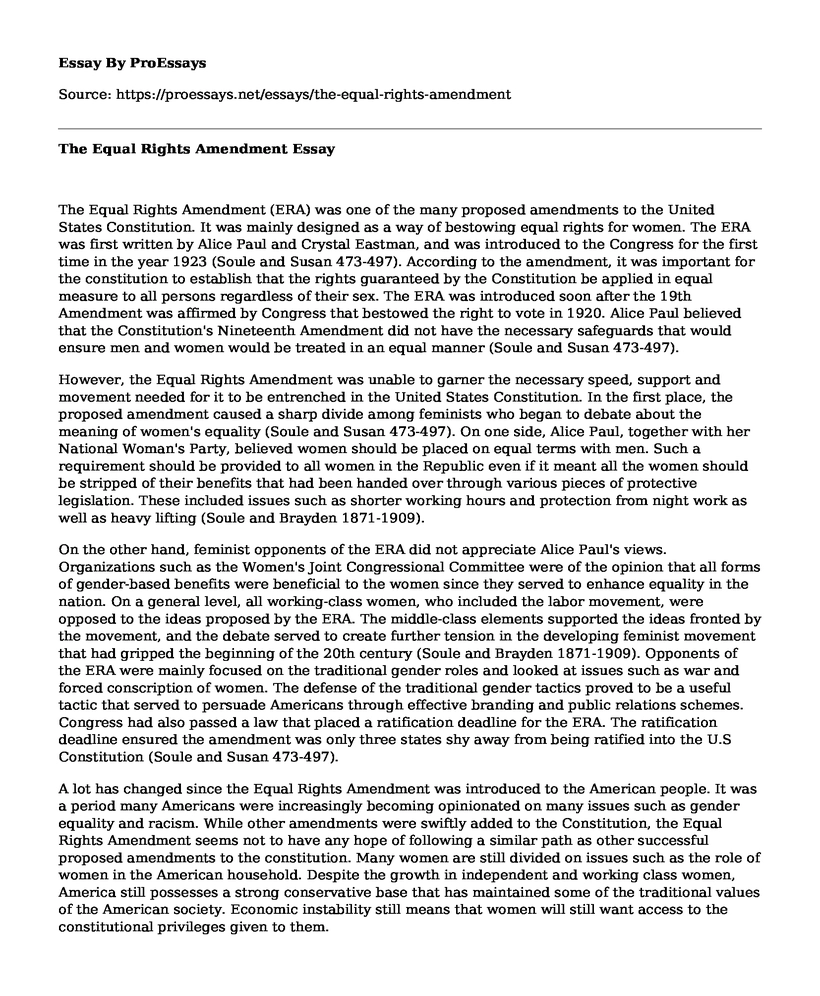The Equal Rights Amendment (ERA) was one of the many proposed amendments to the United States Constitution. It was mainly designed as a way of bestowing equal rights for women. The ERA was first written by Alice Paul and Crystal Eastman, and was introduced to the Congress for the first time in the year 1923 (Soule and Susan 473-497). According to the amendment, it was important for the constitution to establish that the rights guaranteed by the Constitution be applied in equal measure to all persons regardless of their sex. The ERA was introduced soon after the 19th Amendment was affirmed by Congress that bestowed the right to vote in 1920. Alice Paul believed that the Constitution's Nineteenth Amendment did not have the necessary safeguards that would ensure men and women would be treated in an equal manner (Soule and Susan 473-497).
However, the Equal Rights Amendment was unable to garner the necessary speed, support and movement needed for it to be entrenched in the United States Constitution. In the first place, the proposed amendment caused a sharp divide among feminists who began to debate about the meaning of women's equality (Soule and Susan 473-497). On one side, Alice Paul, together with her National Woman's Party, believed women should be placed on equal terms with men. Such a requirement should be provided to all women in the Republic even if it meant all the women should be stripped of their benefits that had been handed over through various pieces of protective legislation. These included issues such as shorter working hours and protection from night work as well as heavy lifting (Soule and Brayden 1871-1909).
On the other hand, feminist opponents of the ERA did not appreciate Alice Paul's views. Organizations such as the Women's Joint Congressional Committee were of the opinion that all forms of gender-based benefits were beneficial to the women since they served to enhance equality in the nation. On a general level, all working-class women, who included the labor movement, were opposed to the ideas proposed by the ERA. The middle-class elements supported the ideas fronted by the movement, and the debate served to create further tension in the developing feminist movement that had gripped the beginning of the 20th century (Soule and Brayden 1871-1909). Opponents of the ERA were mainly focused on the traditional gender roles and looked at issues such as war and forced conscription of women. The defense of the traditional gender tactics proved to be a useful tactic that served to persuade Americans through effective branding and public relations schemes. Congress had also passed a law that placed a ratification deadline for the ERA. The ratification deadline ensured the amendment was only three states shy away from being ratified into the U.S Constitution (Soule and Susan 473-497).
A lot has changed since the Equal Rights Amendment was introduced to the American people. It was a period many Americans were increasingly becoming opinionated on many issues such as gender equality and racism. While other amendments were swiftly added to the Constitution, the Equal Rights Amendment seems not to have any hope of following a similar path as other successful proposed amendments to the constitution. Many women are still divided on issues such as the role of women in the American household. Despite the growth in independent and working class women, America still possesses a strong conservative base that has maintained some of the traditional values of the American society. Economic instability still means that women will still want access to the constitutional privileges given to them.
Works Cited
Soule, Sarah A., and Brayden G. King. "The Stages of the Policy Process and the Equal Rights Amendment, 197219821." American Journal of Sociology 111.6 (2006): 1871-1909.
Mansbridge, Jane J. Why we lost the ERA. University of Chicago Press, 1986.
Soule, Sarah A., and Susan Olzak. "When do movements matter? The politics of contingency and the equal rights amendment." American Sociological Review 69.4 (2004): 473-497.
Cite this page
The Equal Rights Amendment. (2021, May 17). Retrieved from https://proessays.net/essays/the-equal-rights-amendment
If you are the original author of this essay and no longer wish to have it published on the ProEssays website, please click below to request its removal:
- Essay Example on Computer Science: The Future of Society's Tech Needs
- Essay Example on Media's Role in Perpetuating Gender Roles
- Racism: Divisive Fallacies of Social Inequality - Essay Sample
- Essay Example on Racism: A Historical Scourge in the US for Minorities
- Essay Example on Victims of Crime: Rights and Benefits Enshrined in the Constitution
- Essay Example on Marijuana Use in Legalized States: 1979-2016 Review
- Navigating the Shadows: Understanding the Dark Side of Interpersonal Communication in Relationships







